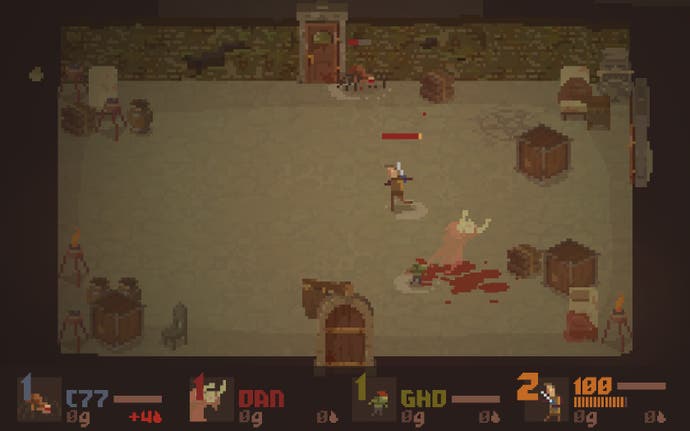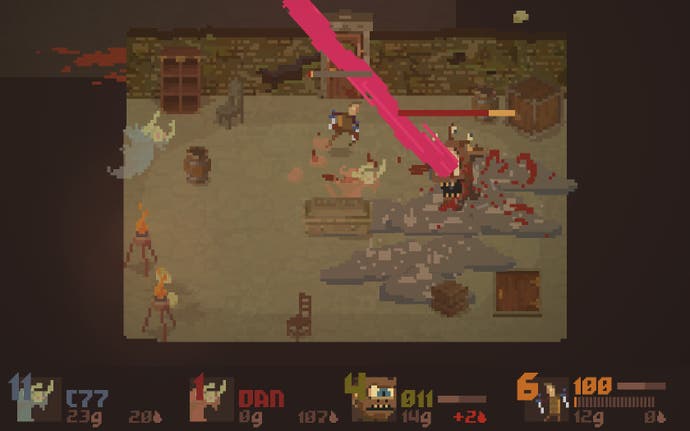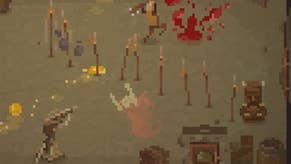Crawl Early Access review
Who's the boss?
Every now and then I meet a skeleton I really like. Crawl's bundle of bones is a case in point. He's slightly top-heavy, with broad shoulders and - unsurprisingly, really - a trim waist. He races about head thrust forward as if running into the wind, and once you level him up, he fires his arrows like he's laying down power chords. This guy's a rattly pleasure to fight alongside and a nagging pain to fight against - and that's Crawl for you, basically: a dungeon-diving spin on musical chairs that already feels more like a sport than a game.
On screen, Crawl is beautiful, its fidgety, blown-up pixel art allowing for elegantly ragged swordsmen, brutish, ham-faced minotaurs, and a final boss who's a squidgy mass of fat tentacles undermined, alas, by his dangerously exposed brain. Animation here is a progression from one comic book pose to another.
On paper, it's equally lovely - a four-player competitive game where one happy fool gets to be the dungeon-raiding hero and the other three get to be the dungeon trying to do that hero in. Whenever the dungeon succeeds, the victor swaps places with the hero and the whole thing repeats. Fight your way up to level 10 and you get to open a portal to the final boss. That's it: a defiantly local-only multiplayer treat. Be warned: bots are available, but in a bickering, grief-centric design like this one, where's the joy in that?
Crawl's good fun at the moment (as long as you have friends close at hand), but it's not quite as good as I think it's eventually going to be - and it's worth remembering that, since this is an Early Access release, it's in an ideal position to fix some of the things that are holding it back. Crawl's not the kind of beta where things are buggy and broken. There's plenty of polish, but underneath that polish are elements that could simply work more enjoyably.
Many of Crawl's issues should be relatively simple to sort out, too: the game's unrelentingly beige environment assets look so samey at present that, pretty as the detailing is, you never get any real sense of the procedural shuffling that's going on - or that one floor of the dungeon is meaningfully different from the next. Other problems are going to be a little trickier to untangle, however: the combat can feel mashy, the action's so hectic you can sometimes lose yourself on screen, and individual matches clock in between 20 and 30 minutes, slowly eroding that vital one-more-go impulse as they grind on.
The first two complaints are definitely related, and they count, too, since combat sits at the very centre of Crawl. The idea is that, as the hero, you're levelling up at lightning speed, zipping from one room to the next, dodging traps and clobbering foes in a race to get the XP you need to open that portal. As a consequence of this, while being the hero is pretty standard ARPG fun, when you're playing as one of the three forces of the dungeon following after him, mileage varies. You spend a lot of your time as a ghost, getting yanked between chambers where you might be asked to fill in as a trap - shooting flames, say, or sending spinning blades across the room - or you might be asked to use any available pentagrams on the floor to summon and then play the role of monsters. You know, tentacle things, armoured weirdos, and skeletons with short health bars but a stinging combination of normal and special attacks.
Initially, the speed set by the hero is completely bewildering: for your first few minutes of play as a ghost, you're likely to be tugged from one set of options to the next with little hope of even touching your quarry, let alone killing them and trading places. Once you get used to the pace of Crawl, though - once you start to understand that it's probably the most inappropriately named game in history - you're still left with the fact that hitting stuff doesn't always feel that exciting. To give the hero sufficient time in the hotseat, monsters tend to lay on damage in tiny increments at first, and regardless of which side you're playing as, there's not enough of a sense of impact or connection to your attacks. Your eyes witness shattering explosions and room-spanning chaos, but your fingers - your gaming soul - are registering something a little more polite.
As the hero levels up, so do the monsters the other players can bring into the world, though. It's a very tidy interconnected system, and it gives proceedings a welcome tactical element - particularly when Team Dungeon is really working together and making smart choices in terms of their various creatures' evolutions. Nasty Fleshy Thing can lay down puddles of toxic slop, for example, trapping the hero in a corner so that Floating Eye can blast him with horizontal tears. Combine this with proper use of traps and - best of all - occasional rooms that allow you to jump into the body of a really big one-off monster, and the blood starts to pump and spurt and splatter and pool as it should.

Elsewhere, the hero can cash in gold at a shop located on each level, buying new weapons and spells and trinkets, and the ghosts can collect cysty little bubbles of goop when they spawn and then trade them for colour-coded lumps of ectoplasm to pitch into the world for low-level aggro. It's three against one, but the designers have clearly spent a lot of time thinking of the balancing. I'd love to know at what point in development that ectoplasm stuff came in, too: it feels like a jerry-rigged solution to instances where there simply isn't much for the dungeon players to do, yet when you combine it with the fact that monster rooms lock the doors until everything's dead, you can actually win big with it if you cast it at the right moment.
Happily, the developers have thrown in lots of other neat little twists that exploit the restless back-and-forth between cooperation and competition. When it comes to transitioning from ghost to hero, for example, getting the last hit in is crucial. You can stump up 99 percent of the damage and then expire just before the hero does, allowing somebody else to land the killing blow and grab the hotseat. At times it may be smarter to hold back and let other people do the dirty work for you with the big guns, in fact, using a weaker offensive option at the absolute last second. Crawl's undoubtedly an action game, in other words, but it has something of gambling to it, too: you have to know when to go all in.
At its very best, Crawl revels in the kind of satisfying bold-strokes tactics its simple, wonderfully mean-spirited template allows for. The end-game, for example, is just brilliant. When the hero makes it through the portal, the remaining three players are dropped into the role of the game's boss: tentacles, bilious spew and laser-eyes pitched against a fully-leveled demi-god in a fight that really comes down to timing and the control of space. In its less inspired moments, Crawl can very occasionally make you feel like one of three spectral onlookers being jerked around by a grinning scavenger as he races through a procession of rooms that don't always give you very much to do.

It's a reminder that so many of Crawl's current issues may be solved by the addition of more stuff - new monsters, new weapons, new spells, new traps. That said, I have a distant, whispering suspicion that some of the underlying problems might simply come down to maths. Three players will always be the bad guys, the henchmen, the stooges, dealing in steady attrition rather than scene-stealing heroics. The hero, meanwhile, has to be hobbled slightly to give these weaklings a shot at replacing him.
The attrition is an indicator that, while 30 minutes is a perfect running time for a proper MOBA, it's a bit of an aeon for something as direct and uncomplicated as Crawl - particularly when the lack of online play forces you to partner up with some well-designed but inevitably rather dry bots. In a shorter game, the switchback of fortunes that Crawl's balancing creates would keep things fresh and filled with opportunities. Here, though, it can ossify into something that feels like a stalemate - although the developer has wisely put a cap on the overall running time by shattering the portal after it's been used unsuccessfully for three boss summons.
Regardless of the problems - maybe even because of their strange nature - I'm rooting for Crawl, and I keep coming back to it to play more, to unlock more, to find new strategies hidden within these creaking beige halls. I'm eager to see where development ultimately leads. Unlike so many Early Access releases, this should be a fascinating project to keep an eye on: a game that promises real pleasures and puts itself forward with palpable confidence - and, occasionally, seems to be struggling rather nobly with the consequences of its own ingenuity.












